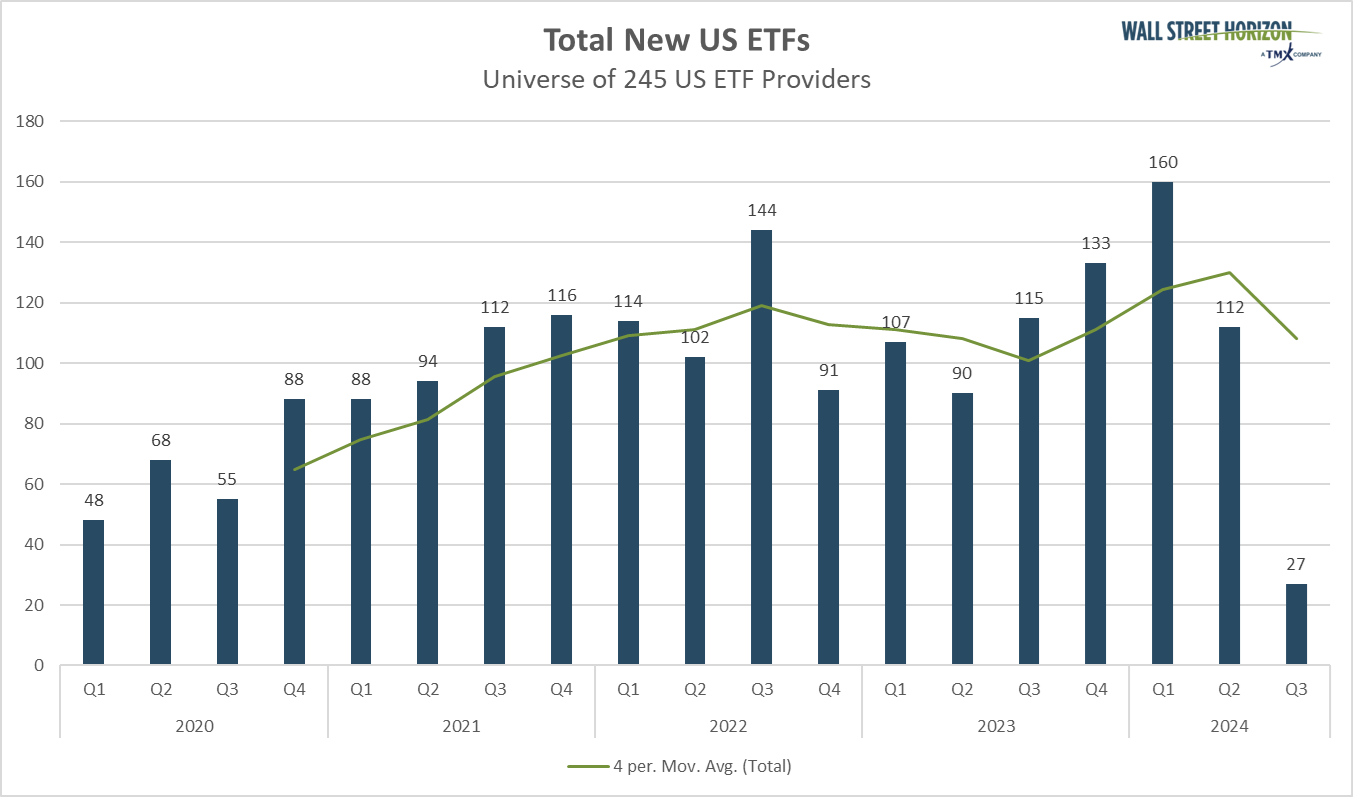-
Through Q2, there has been a record number of new US ETFs on a rolling four-quarter basis
-
Fund issuers have met investors’ demand for high-income equity ETFs, covered-call products, defined-outcome strategies, and single-stock funds
- 2024 has also been the year of crypto ETFs, and funds tracking spot Ether recently began trading
It seems we can always count on Wall Street to come up with ways to scratch all sorts of investors’ itches. That’s seen perhaps most prominently in the ETF space. Among US ETF providers, the four-quarter rolling total of new-fund issuance has never been higher, according to Wall Street Horizon’s data.
It has been a steady climb over the past four years, with the latest increase being driven by demand for high-income ETFs, covered-call strategies, buffer (or defined-outcome) products, single-stock funds, and the latest round of cryptocurrency plays.
Of course, portfolios that track tech and AI remain in vogue. Recent data show that ETFs of the active variety are snatching market share too.
Q2 2024 Marked a Record-High New US ETF Count
Source: Wall Street Horizon
A Market Ripe for Fund Growth
Indeed, there are a handful of prolific themes among investors across the risk spectrum. ETF issuers can create funds with relative ease given today’s technology, though it’s not always a lickety-split and inexpensive process.
Still, as equity markets have risen since the start of last year and amid a bond market bounce back, there might be more capital available than ever before.
And let’s not forget about more than $6 trillion of cash sitting in money market mutual funds – just as the US Federal Reserve is set to embark on a possible cycle of interest rate cuts.
In short, it’s arguably never been a better time to be an ETF issuer, evidenced by more major ETF inflows in July. Competition is intense, however, and fees are always in focus among today’s savvy investors.
“Boomer Candy” in the Limelight
And the most seasoned investors are at the center of the latest ETF hot spot – high-income funds. A set of ETFs aiming to produce a high yield with limited risk has taken off. Eric Balchunas dubbed them “boomer candy” products as they are akin to adding a sweet treat to what’s sometimes bland portfolios.
Critics assert that their high fees and complex structures could cause more trouble than they are worth, while proponents assert that the right portfolio is the one an investor can stick to through the good times and bad, even if it comes at a higher price.
We’ll leave that up to the ETF pundits, but it’s clear that this new fund type is white-hot. FactSet reports that $31 billion has poured into boomer candy products in the past 12 months as of June, according to The Wall Street Journal.
The Different Flavors
Experienced investors and portfolio managers can easily wrap their heads around some of the most popular boomer candy ETFs. Equity premium income strategies generally own a basket of liquid large-cap stocks and then sell options on those positions, thus increasing the potential portfolio payout. The drawback is that the upside is often limited to an extent.
Another supposed ETF sweet treat are buffer funds that claim to protect investors against losses, up to a pre-determined percentage on an index, while capping potential gains.
Once again, options are harnessed to construct the payoff profile. Data show, however, that the higher the yield, the more likely it is that the ETF may underperform the S&P 500. Of course, each ETF has its own benchmark, so it's critical that investors perform their due diligence just as they might on an individual stock.
The Popularity of Single-Stock ETFs
It’s not just older investors who are driving high-yield equity ETFs’ popularity surge. It feels like every day there is a new single-stock fund that applies a covered-call strategy for yield enhancement.
Among the latest offerings are the YieldMax Short NVDA Option Income Strategy ETF (NYSE:DIPS) and the YieldMax ABNB Option Income Strategy ETF (NYSE:ABNY). From both the short and long sides, these ETFs generally use derivatives to build an allocation that mimics a covered call strategy.
You might come across dividend yields north of 30%, but it’s critical to recognize that such a payout is different from the dividend yield on shares of a blue-chip stock. Rather than a portion of a company’s cash flows being paid to holders, the high stated yield is sourced from option-selling premium.
Crypto’s Coming of Age
ETFs tracking the performance of spot Bitcoin and Ether have also taken the street by storm in 2024. Following the US Security and Exchange Commission’s (SEC) approval of 11 spot Bitcoin ETFs in January, funds following the world’s second-largest digital currency began trading in late July.
Many issuers already have Ether ETFs trading, including leveraged, short, and futures-based funds. We even see ETFs that will have exposure to both Bitcoin and Ether in the same portfolio for those seeking crypto diversification.
More choices for retail investors could be a good thing – the VettaFi Galaxy Crypto Mining Index, which is designed to track companies that mine or stake cryptocurrency assets and companies that provide hosting services for cryptocurrency mining or staking, proves that owning shares of crypto-mining firms can be stomach-churning. The index has ranged from 342 to above 1000 (total return) in the past year.
The Bottom Line
ETFs are no longer strictly about offering investors access to low-cost and straightforward indexes. New niche strategies have come on strong to meet growing demand among different types of investors.
High-yield equity ETFs are having a year, while the list of funds using options on individual stocks grows seemingly by the week. And as the crypto market matures, inexpensive Bitcoin and Ether ETFs make being a cryptocurrency player easier than ever.
